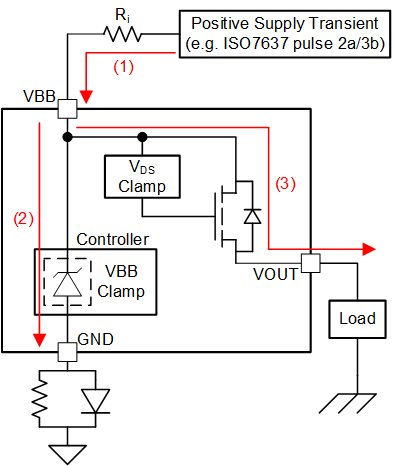SLVSDZ4D February 2018 – February 2020 TPS2HB35-Q1
PRODUCTION DATA.
- 1 Features
- 2 Applications
- 3 Description
- 4 Revision History
- 5 Device Comparison Table
- 6 Pin Configuration and Functions
- 7 Specifications
- 8 Parameter Measurement Information
-
9 Detailed Description
- 9.1 Overview
- 9.2 Functional Block Diagram
- 9.3
Feature Description
- 9.3.1 Protection Mechanisms
- 9.3.2 Diagnostic Mechanisms
- 9.4 Device Functional Modes
- 10Application and Implementation
- 11Power Supply Recommendations
- 12Layout
- 13Device and Documentation Support
- 14Mechanical, Packaging, and Orderable Information
パッケージ・オプション
メカニカル・データ(パッケージ|ピン)
- PWP|16
サーマルパッド・メカニカル・データ
- PWP|16
発注情報
9.3.1.3 Voltage Transients
The TPS2HB35-Q1 device describes two types of voltage clamps which protect the FET against system-level voltage transients. The two different clamps are shown in Figure 38.
The clamp from VBB to GND is primarily used to protect the controller from positive transients on the supply line (for example, ISO7637-2). The clamp from VBB to VOUT is primarily used to limit the voltage across the FET when switching off an inductive load. If the voltage potential from VBB to GND exceeds the VBB clamp level, the clamp will allow current to flow through the device from VBB to GND (Path 2). If the voltage potential from VBB to VOUT exceeds the clamping voltage, the power FET will allow current to flow from VBB to VOUT (Path 3). Additional capacitance from VBB to GND can increase the reliability of the system during ISO 7637 pulse 2-A testing.
 Figure 38. Current Path During Supply Voltage Transient
Figure 38. Current Path During Supply Voltage Transient